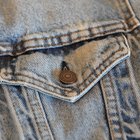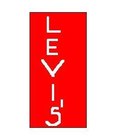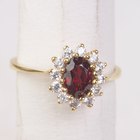The tab on Levi's jeans is not only one of the world's most recognizable trademarks, but according to Levi Strauss & Co., it's also one of the most copied. The famous red tab has graced the pocket of Levi's jeans since the earliest part of the 20th century. A different colored tab, however, does not necessarily mean vintage Levi's are counterfeit. Red and orange tabs both legitimately represent the Levi's trademark.
Levi's Myths and Legends
Vintage jeans aficionados claim many differences and anecdotal tales of variations among Levi's jeans. In 1971, when Levi Strauss & Co. changed the font used for the trademark Levi's, the myth of big and little “E’s” appeared. This is a direct result of the logo shifting from all capital letters to only the first letter capitalized. In vertical stitching, the only letter to have appeared changed was the letter “e,” resulting in the big “E” and little “e” differentiation. Likewise, myths abound that orange tab Levi's were cheap knockoffs made for women with larger curves, and other anecdotal explanations surfaced.
The Orange Truth
In truth, orange tab Levi's made a first appearance in the fashion world in 1969. Orange tab Levi's offered a different stitching method and overall appearance than red tab Levi's. According to Levi Strauss & Co. blog editors, the stitching method used for orange tab Levi's was used from 1969 to 1999. Levi's in Europe offers a present day, vintage recreation of the orange tab jean. The European vintage line offers slightly different options than traditional orange tab Levi's, including skinny jeans and jeans with more curve at the hip.
What is the Difference?
The primary difference between standard red tab Levi's and historical orange tab Levi's rest in the stitching and overall design. Red tab Levi's have six rivets on the front pockets, whereas orange tabs have only five. Orange tab Levi's have seven belt loops, where red tabs have only five. On a pair of orange tabs, the hip pocket has no top stitching, and the inside front pocket features only basic stitching. Back pockets on orange tabs are square, whereas red tabs taper from top to bottom.
Mergers and Rebirths
In 1999, Levi Strauss & Co. incorporated old-style red tab Levi's sewing methods with orange tabs to create a single sewing method for all jeans going forward. The production of both methods independently stopped, and the new consolidated method appeared. The red tab jeans on shelves today are a product of the new consolidated sewing method. In 2001, Levi's in Europe introduced a new vintage line of jeans inspired by sewing methods and styles of the past.
Related Articles

How to Tell How Old Levi's Jackets Are

Information About the Orange Fruit

How to Repair a Rivet Type Button on ...

What Is the Difference Between Levi 505 ...

How to Identify Vintage Levis

How to Date 501 Levis

What Is the Difference in Converse One ...

How to Identify Ralph Lauren Labels

How to Spot Fake 7 For All Mankind Jeans

Physical Characteristics of the Ruby ...

How to Remove a Button on Denim

Patterns to Make a Japanese Kimono

What Is the Difference Between Denim & ...

How to Spot a Fake Lacoste Polo

Levis Jeans Label History

How to Spot Fake Chuck Taylors

How to Tell if a Baseball Jersey is ...

The History of Denim Jackets

How to Spot Fake Levi's Jackets

How to Rip Jeans at the Bottom
References
Writer Bio
Sandra Johnson is a freelance writer, ghostwriting for private clients since 2006, and writing for print and online publications such as Sashay Magazine. She has studied with both Kaplan and Colorado Technical universities for bachelor's degrees in both human resources and accounting. In addition to writing, Johnson also operates a small family farm in rural Georgia.